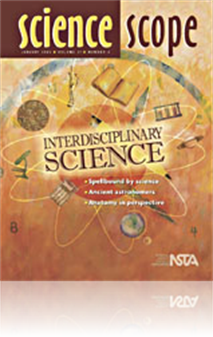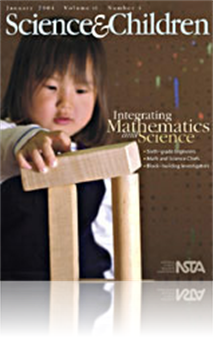All Resources
Journal Article
Science Sampler: The Science and Art of Proportionality
The following activities ask students to compare the proportions of their own bodies with each other and with historical models, specifically with Polycleitus’ statue of Doryphorus (fifth century B.C.). The statue was created as an example of what ...
Journal Article
Scope on the Skies: Saturn, ringed jewel of the night sky
During the next few months, opportunities abound to view four evening planets--Mercury, Mars, Saturn and Jupiter. For early risers, Venus and Jupiter, will also be visible. Despite the variety, probably no planet can come close to "knocking your sock...
Journal Article
Science Sampler: Periodic Table
Teaching the periodic table can be a mundane task filled with repetition and rote memorization. The techniques for engaging activities outlined in this article will help students become familiar with the periodic table in fun and exciting ways throug...
Journal Article
In this article, the teacher moves from a lecture-oriented classroom to a student-centered classroom by redesigning the unit on gas laws based on the five phases of the 5E instructional model—engagement, exploration, explanation, elaboration or ext...
Journal Article
The Idea Bank provides tips and techniques for creative teaching, in about 1,000 words. In this month’s Idea Bank, the teacher introduces the “Bird Beak Lab.” This lab incorporates graphing, data collection, manipulation, interpretation, presen...
Journal Article
The Science and Mathematics of Building Structures
Everyday activities—like building with blocks—can be the basis for meaningful learning that meets national educational standards in science and mathematics. Preschool students played with different kinds of building blocks and were encouraged to ...
Journal Article
Corn Snake Genetics: Students learn about the fundamentals of Mendelism by studying corn snakes
On a visit to a local pet store, one teacher learned that corn snakes can be interesting models for Mendelian genetics. Corn snakes became the focus of a genetics unit that included making observations of classroom corn snakes with different phenotyp...
Journal Article
Teaching through Trade Books: Rock Wonderings
Rocks, as part of the Earth science curriculum, are an integral part of the National Science Education Standards. These trade book-inspired investigations for students in grades K-3 and 4-6 encourage readers to investigate the world around them....
Journal Article
In an effort to improve inquiry learning in the classroom, the authors modified a standard, inquiry-based curricula to provide opportunities for students to discuss discrepant events. The tool, called Hypothesis-Based Learning (HBL), requires student...
Journal Article
Observing the Sky Through the Eyes of the Ancient Mayans
Throughout history, most cultures paid very close attention to the sky. For the Mayan culture specifically, the dependable motions of the Sun, Moon, and stars and their connection to accurate calendars provided motivation to study the cosmos. Through...





